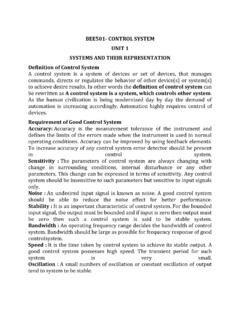Transcription of UNIT-I Automobile electrical and electronics Electrical ...
1 UNIT-I Automobile Electrical and electronics Electrical components in Automobile Automobile Electrical system has gradually evolved over the years and today it assimilates automatic computer control of the automotive mechanics. In the early days, automobiles Electrical system comprised of only basic wiring technologies that were used for distributing power to other parts of a vehicle. It had only switches, wires, relays and controlled motors as its key components but today s Electrical system includes sensors, actuators, alternators, battery, oxygen sensors, generator, starter solenoid, starter drive, high power Electrical system and other devices. Components of Automobile Electrical system 1. armature 2. Automobile battery 3. Automobile ignition system 4. Automobile starting system: 5. automotive computer chips 6. automotive Electrical wiring: 7. charging system 8. spark plugs armature: Armatures are the moving parts of an electric machine generally alternators, generator or motors of a vehicle, which vibrates when electromotive force is produced.
2 The armature used in Automobile comprises of a series of coils and groups of insulated conductors circumscribed around a core of iron. Also known as the rotating part of a dynamo, armatures are generally fixed on ball bearings and are mostly made of copper wire coiled around an iron core. The major functions of armature are: 1. produce an electromotive force. transmit current in a rotating machines and force in a linear Machine Automobile battery: Automobile battery refers to an electrochemical device comprising of primary and secondary cells that are used for transforming chemical energy into mechanical energy. Most of the vehicles today uses lead acid batteries. Batteries are mostly of two types Non-rechargeable and rechargeable. Often called as disposable batteries, non-rechargeable batteries are used once and then dumped. While rechargeable batteries are those devices that can be easily recharged by applying Electrical current that turns or reverses a chemical reaction.
3 A normal battery has an initial voltage of about volts and produces between 500-1000 amps. The market size of Automobile battery industry is worth us $ 48 billion a year. China, hong kong, united states, india and taiwan are the major battery manufacturing countries on the global platform. Classification of various components of a battery includes: battery boxes battery cable terminals battery plates performance batteries ground straps battery cable battery control systems battery trays voltage regulators battery switches Automobile ignition system: Automobile ignition system constitute of various devices, tools and components that are used for igniting the fuel in an internal combustion engine of a vehicle. In this system, electric current is used for burning the mixture of air and fuel with the help of coil, battery, and spark plug. Ignition system is assembled in only those Automobile engines, which operates with the help of petrol or gasoline.
4 The two main functions of Automobile ignition system are to produce enough voltage so that it can easily create a spark for burning air/fuel mixture and secondly it exercises control over the timing of spark and transmit it to the apt cylinder. A typical Automobile ignition system produces voltage somewhere between 20000 volts and 50000 volts from a 12-volt source. Automobile ignition system can be further classified into three main heads such as mechanical ignition system, electronic ignition system and distributor less ignition system. Most of the vehicles today incorporate electronic ignition system in its engine. Major components used in Automobile ignition systems are: coil wires ignition distributor magneto ignition coil parts electronic timing controllers ignition box ignition switch ignition coils ignition controller magneto Automobile starting system: Automobile starting system is considered to be the heart of Automobile Electrical system.
5 The starting system of an Automobile includes those devices, which are used for initiating an engine of a vehicle. Once the key is put into the ignition switch then the current pass through battery cables to starter motor. After this, starter motor turn the engine and the downward moving piston create suction where air and fuel mixture is burned and then the engine starts. The chief components of Automobile starting system are: starter starter solenoid starter drive bendix drive starter automotive computer chips: Automotive computer chips also known as super chip, automotive computer chips are basically the integrated circuits made of semi conducting material that are used for storing a new engine management program in the electronic control unit of the vehicle. These chips stores the data used by engine control unit, for managing and controlling the engine functions. Oxygen sensor is one of the types of Automobile computer chips that form an important part of the engine fuel control feedback loop.
6 Automotive computer chips comprises of: engine management systems sensor ring oxygen sensors Other Automobile computer chips include: Power train control modules tuners speedometer calibrators flip switches Performance monitors performance chips top speed eliminators shift improvers automotive Electrical wiring: The Electrical wiring system of an Automobile incorporate different types of devices, flexible Electrical wires, Electrical fuses, connectors, fuse blocks used for fastening one end of an Automobile component to the power source device. These Electrical wiring components are used for bearing mechanical loads and transmitting communication signals or Electrical energy. Apart from Electrical wiring components mentioned above, there are other parts used in an Automobile Electrical system like: Electrical fuse Electrical switch panels fuse blocks shrink sleeve tubing wiring harnesses a/c harness Electrical switches parts Electrical fuse holders Electrical switches relay connectors wiring connector electricalswitch covers ground straps charging system: The charging system of an Automobile has three basic components such as alternator, regulator, and the interconnecting wiring.
7 The main function of Automobile charging system is to control and regulate the charge in the battery of a vehicle. Automobile charging system generally generates a voltage between and volts when the engine is working. It produces Electrical current for operating Automobile lights, music systems, heater, engine Electrical system and other Electrical components. Other components of charging system of the vehicle are: alternator Automobile generator alternator parts Alternator bearing alternator fans spark plugs: A spark plug is a small Electrical device that is implanted into internal combustion engine cylinder for burning the mixture of air and fuel. A typical spark plug consists of a center electrode, metal casing and a ground electrode as illustrated in the figure. These plugs are used in many machines such as trucks, buses, tractors, boats, aircraft, motorcycles, scooters, industrial and oil field engines, and oil burners. The basic raw materials used for manufacturing spark plugs are aluminum oxide, steel, silver, gold, platinum, copper and other high nickel alloys.
8 These spark plugs are available in different configurations and heat ranges to adapt to any type of engine. Other spark plug components are: spark plug parts spark plug tools spark plug wires Electronic diesel control Edc distributor injection pump Electronic diesel control is a diesel engine fuel injection control system for the precise metering and delivery of fuel into the combustion chamber of modern diesel engines used in trucks and cars. Contents introduction system overview components operation additional functions references Introduction Edc injection inline pump The mechanical fly-weight governors of inline and distributor diesel fuel injection pumps used to control fuel delivery under a variety of engine loads and conditions could no longer deal with the ever increasing demands for efficiency, emission control, power and fuel consumption. These demands are now primarily fulfilled by the electronic control, the system which provides greater ability for precise measuring, data processing, operating environment flexibility and analysis to ensure efficient diesel engine operation.
9 The edc replaces the mechanical control governor with an electro-magnetic control device. The edc is divided into these main groups of components. electronic sensors for registering operating conditions and changes. A wide array of physical inputs is converted into Electrical signal outputs. actuators or solenoids which convert the control unit's Electrical output signal into mechanical control movement. ecm (electronic control module ) or engine ecu (electronic control unit) with microprocessors which process information from various sensors in accordance with programmed software and outputs required Electrical signals into actuators and solenoids. Components] Edc accelerator pedal assembly sensors Injection pump speed sensor - monitors pump rotational speed Fuel rack position sensor - monitors pump fuel rack position Charge air pressure sensor - measures pressure side of the turbocharger Fuel pressure sensor Air cleaner vacuum pressure sensor Engine position sensor Temperature sensors - measure various operating temperatures Intake temperature Charge air temperature Coolant temperature Fuel temperature exhaust temperature (pyrometer)
10 Ambient temperature Vehicle speed sensor - monitors vehicle speed Brake pedal sensor - operates with cruise control, exhaust brake, idle control Clutch pedal sensor - operates with cruise control, exhaust brake, idle control Accelerator pedal sensor Driver input switches - cruise control, idle increase /decrease, engine/exhaust brake Injector needle movement sensor - monitors the actual injection time and feeds the information to the ecu (as used on vm motori and engines) electronic control unit Edc control unit The ecu collects and processes signals from various on-board sensors. An ecu electronic module contains microprocessors, memory units, analog to digital converters and output interface units. Depending upon the parameters, a number of different maps can be stored in the onboard memory. This allows the ecu to be tailored to the specific engine and vehicle requirements, depending on the application. The operating software of the ecu can be adapted for a wide variety of engines and vehicles without the necessity of hardware modification.











